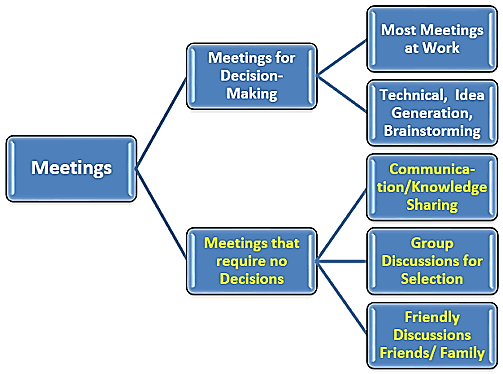and Brain Storming Sessions
Related Articles
| Published in Journals

Published in 10 Journals
This article has been published as an academic paper in 10 international management journals like Leadership & Organizational Behavior eJournal, Psychology & Human Decision-Making eJournal, Decision Making & Negotiations eJournal, etc.
Click here to see full list of journals with Issue date and Issue number.
Abstract
Group discussions, meetings, and friendly arguments are integral parts of both professional and personal lives. Effective participation in such discussions requires awareness of the rules and etiquettes of such meetings, as well as of our own roles and responsibilities as participants.
This paper delves into various types of meetings and discussions, including
- Business Meetings (or Decision-making discussions for actionable outcomes)
- Brainstorming sessions for idea generation
- Communication and knowledge-sharing meetings
- Group discussions for competitive exams like MBA
- Friendly discussions during social and family gatherings
In a work environment, where hierarchies exist and normally a senior person conducts the meeting, clear roles and responsibilities for both the coordinator and participants are crucial for the effectiveness of meetings.
The author explores the common pitfalls encountered in brainstorming sessions and emphasizes the need to strictly avoid these pitfalls to ensure that the best and most creative ideas are generated. Furthermore, he delves into the essential rules for effective participation in competitive group discussions and provides strategies for making a positive impression on selectors.
Friendly discussions too can at times escalate into heated arguments resulting into negative emotions unless we understand and adhere to the ground rules. The author provides insights into how we can actually enjoy academic discussions without allowing differences of opinions to lead to ill feelings.
The author highlights techniques and approaches to ensure focussed and result-oriented meetings at work, as well as to foster a positive and constructive atmosphere during academic exchanges, promoting mutual respect and understanding among participants.
Types of Meetings
In both professional and personal settings, group discussions, meetings and friendly arguments are common occurrences. Effectively participating in such discussions requires awareness of the rules and etiquettes of such meetings and of our own roles and responsibilities as participants. Our roles and responsibilities change depending on the nature of the discussion and the contributions expected from us.
Meetings can broadly be categorized into two types (Fig. 1):
1. Meetings for Decision-Making :
These meetings are essential for making decisions that lead to actionable outcomes. In a work environment, most meetings fall under this category. Discussions in these meetings typically result in a conclusion or decision followed by a planned course of action.
2. Meetings that Require No Decisions:
Communication meetings or knowledge-sharing sessions in the workplace fall into this category as they are primarily focused on exchanging information. Other examples include group discussions in competitive examinations (such as MBA entrance exams) and informal academic discussions for leisure or fun with family and friends. New age discussions on social media platforms like Facebook also exemplify this type of meeting.

As shown in Fig. 1, the two categories can be further subclassified as follows:
Meetings/Discussions for Decision Making- Business Meetings, or Discussion for decision making and/or appropriate action at work
- Technical discussions, brainstorming sessions for generating new ideas or possible solutions to a problem, and then selecting the best.
- Communication meetings and Knowledge sharing meetings at work
- Group Discussions for Competitive exams like MBA
- Friendly Discussions among family and friends - purely for leisure and fun
The author also provides insights into effective participation in competitive group discussions, aiming to impress selectors. Additionally, friendly discussions can sometimes escalate into heated arguments and negative feelings unless the ground rules are understood. The author explores strategies for enjoying academic discussions without creating animosity due to differences of opinions.
Meetings for Decision Making and Action

Characteristics of such Meetings
Business meetings are primarily of this type needing decision and action. They typically exhibit the following characteristics:
- These meetings are expected to lead to a conclusion or decision by the end.
- In many cases, there is a coordinator who also acts as the decision maker. This person often makes the final decision after considering input from other participants.
- Participants in these meetings are directly impacted by the decisions made and usually are also the ones responsible for implementing the actions decided upon.
- These meetings often have time constraints, requiring discussions to be concise and productive, with a deadline for reaching decisions.
There is a misconception that corporate group meetings are for joint decision-making. In reality, while participants have the freedom to express their views and opinions, the final decision-making authority usually rests with one individual.
Benefits of Meetings

Despite one-man decision, participants often feel satisfied for having the opportunity to voice their perspectives and contribute to the decision-making process. This fosters a sense of involvement, ownership and collaboration within the organization.
Such meetings and discussions have other benefits in terms of motivating people:
- Psychological Effect and Compliance: Consulting employees and involving them in discussions can have a positive psychological impact, leading to smoother implementation of decisions due to increased buy-in and ownership.
- Expression of Views: Meetings provide a platform for employees to express their opinions and contribute to the decision-making process, thus giving them a sense of satisfaction.
- Venting Frustration: Meetings can serve as a means for employees to release pent-up frustration or stress, which can otherwise affect their performance negatively.
- Employee Motivation: Being part of important decisions can boost employee motivation and engagement, as they feel valued and included in the decision-making process.
- Informed Decision Making: The decision maker gains valuable insights and information about potential repercussions. Not only can this help in a more informed decision, it can also aid in a better-planned implementation.
- Promotes Interaction and Information Sharing: Meetings facilitate interaction among employees, promote collaboration, and keep participants informed about important updates and developments within the organization.
Rules of Corporate Meetings for Decision Making
For corporate meetings and meetings for decision making to be effective, it is crucial that both the meeting coordinator and the participants are clear of their roles and responsibilities.
Responsibilities of the Co-ordinator

The responsibilities of a meeting coordinator or leader are crucial in ensuring productive and effective discussions. Here are some key responsibilities of the coordinator:
- Define Meeting Objectives: Clearly define the objective of the meeting or the topic being discussed. This helps participants stay focused and ensures that discussions contribute to the intended goal.
- Define Problems Clearly: Clearly articulate the problem or issue being discussed to avoid confusion and ensure everyone understands the context. A small difference in defining the problem or the meeting objective can alter the course of the discussion.
- Maintain Focus: Ensure that the discussion stays on track and does not deviate from the main objective. Bring the discussion back on track if it starts digressing. It is very common that one comment may lead to another and the discussion may digress completely from the topic.
- Give Everyone a Chance to Speak: Encourage participation from all participants and ensure that everyone gets an opportunity to voice their opinions.
- Prevent Dominance: Be vigilant to prevent a few individuals from dominating the discussion, and ensure that quieter participants have a chance to speak.
- Encourage Participation: Encourage quieter or hesitant participants to contribute to the discussion by gently coaxing them to share their thoughts.
- Respect Ideas: Ensure that ideas are not ridiculed, and all participants are given a fair chance to express themselves without being shut down. This is a very common pitfall. Sometimes seemingly ridiculous ideas can lead to innovation if they are allowed to survive the "reflexive rejection" syndrome.
- Ensure Balanced Participation: Prevent the meeting from becoming a dialogue between a few individuals, and encourage active participation from the majority of participants.
- Maintain Order: Ensure that participants speak one at a time and raise their hand to request the floor.
- Foster Free Communication: Encourage open and free communication within the group. Let everyone express freely.
- Promote Creativity: Encourage diverse views and ideas, as they can lead to innovative and creative solutions.
- Build Team Spirit: Create a sense of togetherness and team spirit among participants to promote collaboration and cooperation.
- Informal Atmosphere: Ensure that the meeting is held in an informal atmosphere to encourage open communication and participation.
- Result-Oriented: Ensure that the meeting remains focused on achieving results and making decisions that align with the meeting objectives.
It is also important for senior coordinators to create an environment where subordinates feel comfortable expressing their views and challenging the coordinator's views if necessary. However, it should be made clear that, in the interest of the whole proceedings, the final decision rests with the coordinator in the absence of a consensus.
Occasionally, discussions may involve both senior colleagues and their direct reports. Juniors often refrain from speaking or challenging their superiors. It is crucial for the boss to actively encourage their subordinates to contribute. It is the boss's responsibility to manage their ego and demonstrate receptiveness to listening, fostering an environment where subordinates feel comfortable expressing themselves.
When I have conducted meetings, I have encouraged people to freely argue and counter-argue against my point of view. But I made it very clear first thing in the meeting that finally, having heard all arguments and views, the prerogative to take final decision was mine.
By encouraging debate and welcoming diverse perspectives, you foster a culture of open communication and critical thinking within your team. This approach not only leads to better-informed decisions but also promotes a sense of empowerment and ownership among participants. Creating an environment where everyone feels free to express their opinions and engage in discussions can lead to better decision-making and a more collaborative work environment.
Responsibilities of Participants: Recommended Code of Conduct

Whereas the Meeting coordinator has a role cut out for him and has clear cut responsibilities, the participants too should be aware that they have important roles and responsibilities to ensure productive and respectful discussions. Here are some recommended codes of conduct for participants.
Be Open to Listening
- Be Open to Listening: Participants should actively listen to others' views and opinions without interrupting or dismissing them.
- Encourage Expressing Views: Participants should encourage and welcome others to express their views and arguments, even if they differ from their own.
- Avoid Discouraging Others: No participant should discourage others from arguing or expressing their viewpoints, no matter how unconventional they may seem initially.
- Respect Divergent Views: All views, even those that may initially appear foolish or divergent, should be listened to and treated with respect. Encouraging non-standard views can lead to innovative ideas and solutions. There is a natural tendency of all the participants to nip in the bud some divergent view being expressed.
- Embrace Brainstorming: Participants should adopt a brainstorming approach where new ideas are welcomed, and participants refrain from rejecting or ridiculing new ideas. This approach fosters creativity and open-mindedness.
Know the Meeting Etiquettes
Here are some important meeting etiquettes that participants should follow:
- Respect Others' Individuality and Views: Acknowledge and respect the opinions and perspectives of others, even if they differ from your own.
- Participate Actively: Engage in the discussion and encourage others to participate as well.
- Practice Speaking Protocol: Ensure that only one person speaks at a time by raising a hand to indicate a desire to participate.
- Avoid Interruptions: Refrain from interrupting others or speaking before someone has finished expressing their thoughts.
- Avoid Cross Talk: Do not engage in side conversations or cross talk during the meeting, as it can disrupt the flow of discussion.
- Focus on Group Discussion: Avoid engaging in individual discussions in small groups during the meeting. Maintain focus on the group discussion at hand.
- Punctuality: Arrive at the meeting venue on time, respecting the scheduled start time of the meeting.
- Encourage Participation: Encourage and facilitate participation from all participants, ensuring that everyone has an opportunity to speak.
- Stay on Topic: Stick to the subjects and agenda items of the discussion without deviating into unrelated or loose talk.
- Be Concise: Keep your contributions brief and to the point, conveying your thoughts clearly and succinctly.
Keep Your Ego in Check

It is not uncommon for certain participants to interpret some arguments as direct assaults on their ego or as being driven by personal agendas. While it is possible for arguments to be influenced by personal agendas (given human nature), an excessive tendency to take arguments personally could impede the attainment of group goals.
Imagine you are holding a rock or an unusual object from Mars in your hand. You would inspect it thoroughly, examining it from every angle. Similarly, approach the current issue as if you are examining an unknown object, scrutinizing it from all sides with an open mind, just like you would with the rock. Personal feelings and ego often contribute to the problem.
Participants in meetings should maintain an open-minded approach and understand that arguments are not necessarily personal attacks but rather contributions to achieving the company's or group's objectives. It is important to create a professional environment where differences in views are respected, and discussions are focused on problem-solving and decision-making. By appreciating diverse perspectives and avoiding taking remarks personally, participants can contribute positively to the process and help discuss all aspects of a problem thoroughly.
Participants should refrain from taking offense if their ideas are not accepted. The focus should not be on whether individual ideas are accepted or rejected, but rather on the group collectively reaching a conclusion. While unanimous agreement within the group is ideal, the leader may need to make the decision if consensus cannot be achieved.
All participants should have an open-minded attitude and understand that hierarchies exist to facilitate the functioning of businesses. In the absence of a clear collective decision, the president retains the authority to make the final decision.
Participants should refrain from expressing sentiments such as "I always said this..." or "If only you had listened to me..." after a decision is made. It is crucial to understand that once a decision is reached, it becomes a collective decision that everyone should accept and take ownership of. All participants should gracefully accept the decision and its outcomes, recognizing that this is the essence of decision-making and the only way to move forward. While there might be instances of incorrect decisions, it is preferable to having no decisions at all.
While this perspective may seem idealistic, it is essential for each participant to embrace this reality to avoid disappointment and frustration during meetings.
Keeping ego in check is crucial during meetings and discussions to maintain a professional and productive environment.
Rules of Brainstorming Sessions/ Technical Meetings

Technical meetings and brainstorming sessions require a nuanced approach compared to managerial meetings. Managerial issues are often subjective, leading to diverse opinions and lower chances of consensus. In such cases, the decision maker may need to exercise their prerogative to make the final decision.
On the other hand, technical meetings involve discussions where opinions matter less. These discussions are usually more objective, allowing for a greater focus on factual analysis and problem-solving. The approach and strategy in technical meetings should reflect this objective-oriented mindset to ensure productive discussions and effective conclusions.
In brainstorming sessions, I have observed that there are two critical phases, each with its specific requirements. These two phases are:
- Identifying Alternatives: This phase involves generating a wide range of potential solutions or ideas related to the topic at hand. It is essential to encourage creativity and open-mindedness during this phase, allowing participants to freely express their thoughts without judgment.
- Examining the Pros and Cons for Each Alternative: Once alternative ideas have been generated, the next phase is to thoroughly evaluate each alternative by considering its advantages (pros) and disadvantages (cons). This phase requires critical thinking, analysis, and a systematic approach to weigh the merits and drawbacks of each option.
However, there are a few pitfalls, or common mistakes which are often made during these two phases.
Pitfall 1
One common pitfall in brainstorming sessions is the premature focus on examining the pros and cons of ideas (phase 2) without fully exploring all alternatives (phase 1). There is a very high tendency to jump into analysing an idea the moment one alternative or idea is suggested. This needs to be consciously avoided. To mitigate this, it is advisable to allocate a specific time to phase 1 before transitioning to phase 2. This helps in ensuring that all potential alternatives are thoroughly considered before diving into detailed evaluations.
The group leader plays a crucial role in guiding the discussion and redirecting the group back to generating new alternatives whenever the group tends to rush into analyzing the merits and drawbacks of the first suggested idea. Avoiding the temptation to prematurely jump into phase 2 before having devoted sufficient time to identify all possible alternatives in phase 1 is a critical aspect of successful brainstorming meetings. This according to me, is the most common and perilous pitfall. Avoiding this pitfall is key to maximizing the effectiveness of the brainstorming process and fostering innovative thinking.
We refer to prematurely jumping into phase 2 as the most perilous pitfall because it is the stage characterized by numerous heated arguments and a flurry of counter-arguments, often leading to intense discussions. Rushing into detailed discussions too soon can lead to spending excessive time debating the first idea that comes up, potentially overlooking better alternatives. This hastiness may cause us to overlook a comprehensive exploration of all potential options.
To address this, I often allocate extra time, such as an additional 5 minutes of silent brainstorming, before diving into discussions of alternatives. This allows participants to think deeply and come up with new ideas that might otherwise be missed in rushed discussions. By reserving fixed time specifically for brainstorming and listing alternatives, we create a structured approach that maximizes the chances of identifying and exploring all potential options effectively.
Pitfall 2
Another common pitfall in brainstorming sessions is the hasty rejection of ideas that may initially seem impossible, improbable, or impractical, even ridiculous. It is important to remember that brainstorming is about generating diverse and innovative 'out-of-the-blue' ideas, including those that may seem outlandish at first glance. Rejecting ideas too quickly without exploring their potential is a critical mistake that can hinder creative thinking and limit the range of alternatives considered.
As a group leader, it is essential to foster an environment where all ideas are welcomed and encouraged, regardless of how silly, unconventional or seemingly unrealistic they may appear initially. In phase 1, the leader must ensure that all such suggestions and ideas are listed, however ridiculous they may appear. This involves refraining from immediate dismissal of ideas and instead allowing space for exploration and discussion. By avoiding the spontaneous rejection of ideas based on initial impressions, we open up the opportunity for unexpected and valuable insights to emerge during the second phase of evaluation.
Discussions Requiring no Decision or Action
Discussions that do not require decisions or immediate action are also an integral part of communication and knowledge sharing. These types of discussions serve different purposes and require a distinct approach from decision-making meetings. Here are three major types of discussions that fall into this category:
- Communication meetings and Knowledge Sharing meetings: These meetings focus on exchanging information, sharing updates, and discussing topics relevant to the organization or team. They are not aimed at making decisions but rather at enhancing understanding and collaboration among participants.
- Group discussions in interviews/selection processes: These discussions are typically part of recruitment processes or academic assessments, where candidates are evaluated based on their communication skills, problem-solving abilities, and teamwork. The goal is to assess candidates' suitability for specific roles or positions.
- Friendly group discussions with family and friends: Informal discussions with loved ones or social gatherings often involve sharing experiences, exchanging opinions, and enjoying each other's company. These discussions contribute to building relationships and fostering a sense of community.
Rules of Communication Meetings

Communication meetings and Knowledge Sharing meetings are common at work and outside work environment. They are essential for exchanging information, updates, and insights among team members or stakeholders. Discussions can be one-to-many or many-to-may depending on who has or have the information and knowledge to share. While these meetings may not have strict rules, there are some general guidelines for effective participation:
- Actively Participate: Engage in the discussion by sharing your thoughts, ideas, and experiences related to the topic at hand. Active participation helps in enriching the discussion and promoting knowledge sharing.
- Listen Attentively: Pay attention to what others are sharing and be open to learning from their perspectives. Listening attentively fosters a collaborative and inclusive environment.
- Share Relevant Information: Contribute relevant information, insights, or updates that add value to the discussion. Avoid digressing into unrelated topics to keep the conversation focused.
Rules of Group Discussions
Several selection processes have group discussions to assess the candidates. For instance, most of the management institutes have group discussions as a part of their selection process.
Here are some tips for such group discussions.
I have noticed that many students enter such discussions with the mistaken belief that dominating the conversation will impress the selectors. Here are some tips for aspiring candidates based on my personal experience during a group discussion for admission to the management institute, IIM Calcutta, where I was successfully selected. The topic of the discussion was "Can Women be Effective Managers?"
When the discussion began, two participants immediately dominated the conversation, not allowing others to speak and seeking to hog the limelight and draw attention of the selectors. They primarily discussed the physical strength of males compared to females, suggesting that women are too weak to excel as managers.
Despite this, I managed to interject and introduce a different perspective. Here is what I conveyed:
"Colleagues, it appears that our discussion has largely centred on physical attributes such as strength or weakness. However, I believe effective management relies more on mental and emotional fortitude rather than physical prowess. From my observations among family and friends, I find that women often exhibit greater emotional strength than men. I acknowledge that my viewpoint may be influenced by my personal experiences and biases. I invite the views of other participants based on their own observations and encounters. Let us hear out this young lady who is trying hard to say something."
In fact, there was this lady who was struggling to voice her thoughts but was unable to do so. I encouraged her to share her perspective on the topic.
My intervention here helped me hit several birds in one stone:
- It provided an opportunity for other candidates to express more diverse or even conflicting opinions.
- It shifted the discussion from a one-sided or two-sided conversation to a more inclusive dialogue.
- It underscored the importance of having multiple participants contribute their viewpoints in such discussions. In real-world business scenarios, a wider range of ideas and perspectives often leads to better decision-making.
- By clarifying that my viewpoint was subjective and that others might have different opinions, I demonstrated my willingness to consider alternative viewpoints. I did not insist that my views were the only valid ones while dismissing others' perspectives.
- Another big misconception of many participants in such discussions is that having the "correct" or "strong" opinions is crucial. However, there are no absolute right or wrong opinions; there are only perspectives. What truly matters is presenting your ideas as personal viewpoints, remaining receptive to different perspectives, and encouraging others to contribute with a diverse range of opinions. By inviting more views and opinions you are seen as helping the consensus-building process and collective decision-making.
- By inviting a lady participant who was struggling to express her views, I demonstrated my willingness to give opportunities to and hear out not just the less vocal members in the group, but the most important member in the group as the topic was about women.
Rules of Friendly Discussions
 Friendly discussions within a group of friends or family members often revolve around shared interests, personal preferences, and common topics of interest. In today's digital age, such discussions are also prevalent on platforms like Facebook and in the comments section of online news articles. However, without the right attitude, these discussions can escalate into heated arguments as opposing parties resort to abuse and offense. This can leave participants feeling hurt and strained, and in extreme cases, it can even lead to real-life conflicts.
Friendly discussions within a group of friends or family members often revolve around shared interests, personal preferences, and common topics of interest. In today's digital age, such discussions are also prevalent on platforms like Facebook and in the comments section of online news articles. However, without the right attitude, these discussions can escalate into heated arguments as opposing parties resort to abuse and offense. This can leave participants feeling hurt and strained, and in extreme cases, it can even lead to real-life conflicts.
It will help if you remember the following rules of such friendly discussions:
- The first and most important rule of a friendly discussion is to approach it as intellectual game rather than a debate. Engage in it with a sportsmanlike spirit, focusing on presenting arguments and counter-arguments rather than winning or losing, or being right or wrong.
- The socond important rule is to learn to distinguish between opinions and facts. Opinions vary among individuals, whereas there is only one fact. A fact is verifiable as right or wrong, an opinion is not.
- There are no absolute right or wrong opinions, only differing viewpoints. There is no universal truth either, especially for topics commonly debated in friendly discussions.
- Think of it as playing a game of chess or cards wherein you make strategic moves and counter-moves. However, there are no absolute aces and trump cards in this game. What one person views as an ace or trump card may differ from others' perspectives. Every player thinks his is a trump card.
- Unlike a game of chess, there is no checkmate - this game always ends in a draw. Every participant tries to respond with the best move. At the end, you shake hands, as after all you were just exchanging opinions, not establishing facts.
- One who always expects a checkmate, is a poor participant of debates and will be miserable. There are no winners or losers.
- Don't be upset if you are not able to convince others of your viewpoint, they will never be.
- Appreciate that discussions help clarify your thoughts and improve your ability to express them clearly and persuasively in future discussions.
- Remember that the majority opinion does not equate to being right. An opinion is always an opinion, never a fact. An opinion is subjective and does not transform into a fact even if many people share the same view. It still remains "many people's opinion".
- Galileo was the lone person saying that the earth revolves around the sun, and there were several millions saying that the sun moves around the earth. Yet he was finally proved right, highlighting that truth is not determined by popular opinion!
- All participants need to be treated as equal - there is no difference due to age, gender, education, position in the family or social status. Wisdom and correctness of opinions are not inherently linked to these factors.
- Each person is different, and has different opinions and views. Each person has a right to his or her opinion. Appreciate and respect the individuality of people.
Remember that friendly discussions are meant to be enjoyable and engaging, akin to playing a game. Avoid letting personal egos get in the way, as this can lead to conflicts and misunderstandings. Opinions are opinions, and never facts.
eJournals where this article has been published
This article has been published as an academic paper in the following eJournals/Issues. You may need to login to ssrn.com site to view details of these journals. At this link at ssrn site, however, you can read the abstract of the paper and also download a pdf copy of the article. You do not need to log in to do so.
Rules for Effective Meetings and Brain Storming Sessions
| Journal Name | Date | Volume | Issue No |
| Decision-Making & Management Science eJournal | March 25, 2021 | Vol 2 | Issue 58 |
| Psychology & Human Decision-Making eJournal | March 26, 2021 | Vol 3 | Issue 6 |
| Decision Making & Negotiations eJournal | March 09, 2021 | Vol 12 | Issue 2 |
| Leadership & Organizational Behavior eJournal | March 17, 2021 | Vol 12 | Issue 7 |
| Change Management & Organizational Behavior eJournal | March 17, 2021 | Vol 12 | Issue 5 |
| Power, Politics, & Organizational Behavior eJournal | March 30, 2021 | Vol 12 | Issue 4 |
| Human Resource Management & Organizational Behavior eJournal | March 12, 2021 | Vol 12 | Issue 11 |
| Emerging Research within Organizational Behavior eJournal | March 11, 2021 | Vol 12 | Issue 5 |
| Scheduled in Strategy & Organizational Behavior eJournal | July 30, 2021 | ||
| Included in eLibrary in: Management Practice eJournal | |||
| Classification Under Review in Employee Social Responsibility & HR Practices eJournal |
Related Readings on Management in My Site:
- Seminar on Conducting Effective Meetings and Group Discussions
- Effective Meetings
- Goal Orientation
- On Quality
- Improving the Emploability Skills of Engg/IT Students
- Team Management & Skill Development Articles
- On Subconscious Mind
- More Articles on Psychology by Prem Kamble
- More Articles for Managers
- All Articles by Prem Kamble
- More Seminars for Top Managers
Also See: